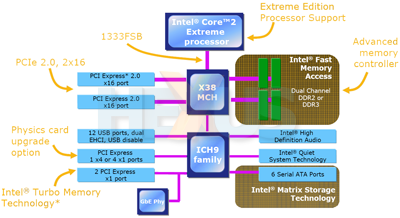The X38 chipset
The X38 is a new member of the Bearlake family, so there are many fundamentals that are similar to the P35 and G33.
Each of the three supports CPUs with front-side bus speeds of 800MHz, 1066MHz and 1333MHz (those with 533FSB Celeron Ds or Pentiums need not apply), has a memory controller that supports DDR2 and DDR3 RAM and is paired with a derivative of the ICH9 south-bridge.
That's not to say that Intel's engineering have been sitting around for the past four months twiddling its thumbs and has simply slapped on a new logo. Far from it.
The most obvious change with the X38 chipset is to the MCH's PCI Express controller.
Gone is the single 16x configuration of the P35, replaced by a whopping 32 lanes of PCIe Gen 2 goodness, with 16x lane PEG slots. Having all 32 lanes running to the northbridge is not a true first. ATI did the same for its AMD-based RD580 chipset, but it's not something we've seen before on an Intel platform. NVIDIA did introduce 16x + 16x solutions but these saw the northbridge and southbridge taking 16 lanes each.
What is a genuine first, though, is the inclusion of support for PCIe Gen 2. This means that if you use a pair of graphics cards that are compliant with PCIe Gen 2 compliant, then each CrossFire card get four times the bandwidth that available to PCIe 1.0a cards in an 8x + 8x configuration on 975X.
Compared to a P35 system, the bandwidth to the first card will be doubled, while for the second it is increased a massive eight times.
This sounds impressive but, in the real world, the performance difference is unlikely to be major. Both 975X and P35 tend to perform very similarly in CrossFire mode, and no current card can take full advantage of a standard, 4GB/sec full-duplex, PCIe 16x link, let alone the 8GB/sec in each direction on offer with X38.
Unfortunately, although there may be a surplus of PCI Express bandwidth, one area where the X38 can't improve over 975X is in terms of SLI support. While there is almost certainly no technical reason why SLI isn't supported, it would appear that NVIDIA refused to grant Intel a license, so as to protect sales of its nForce motherboard range.
Support for CrossFire is included, despite AMD's takeover of ATI and its rivalry with Intel, but, of course, every sale of a system centred on the X38 chipset represents one lost sale of an AMD processor.
Lots of PCIe lanes means lots more pins on the chipset package - at least another 64 for signalling and potentially more for power and grounding. The X38 team has fitted a heatspreader over the MCH die to help ensure the heatsink sits flat, protecting the die from damage and helping to ensure optimal cooling of what must be a fairly power-hungry chip.
Intel has also tweaked the X38's memory controller, adding support for modules featuring its Extreme Memory Profiles (XMP). This sees additional information in the modules' SPD being used to provide out-of-the box overclocking.
This may sound a lot like NVIDIA's SLI memory but don't worry, Intel isn't doing anything crazy like co-operating with NVIDIA. XMP only applies to DDR3 memory and, if the X38 is presented with DDR2 featuring EPP profiles, it will ignore them. Terrific! :-(
Intel has also implemented a Windows-based chipset-tuning utility. Much like NVIDIA's nTune, this ties in with the BIOS to offer the user additional monitoring and tweaking potential.
Finally, Intel promises that "Chipset Overspeed Protection has been removed". That presumably means we should be able to push front-side bus speed somewhat further than on limited chipsets.
Summary
With the exception of PCIe Gen 2 support, which at present is mostly irrelevant, X38 does little that is genuinely new and innovative. What it does do, however, is bring together all the best features from the currently-available chipsets into one product.
What is disappointing, though, is the inability of Intel and NVIDIA to co-operate over SLI graphics and memory.











